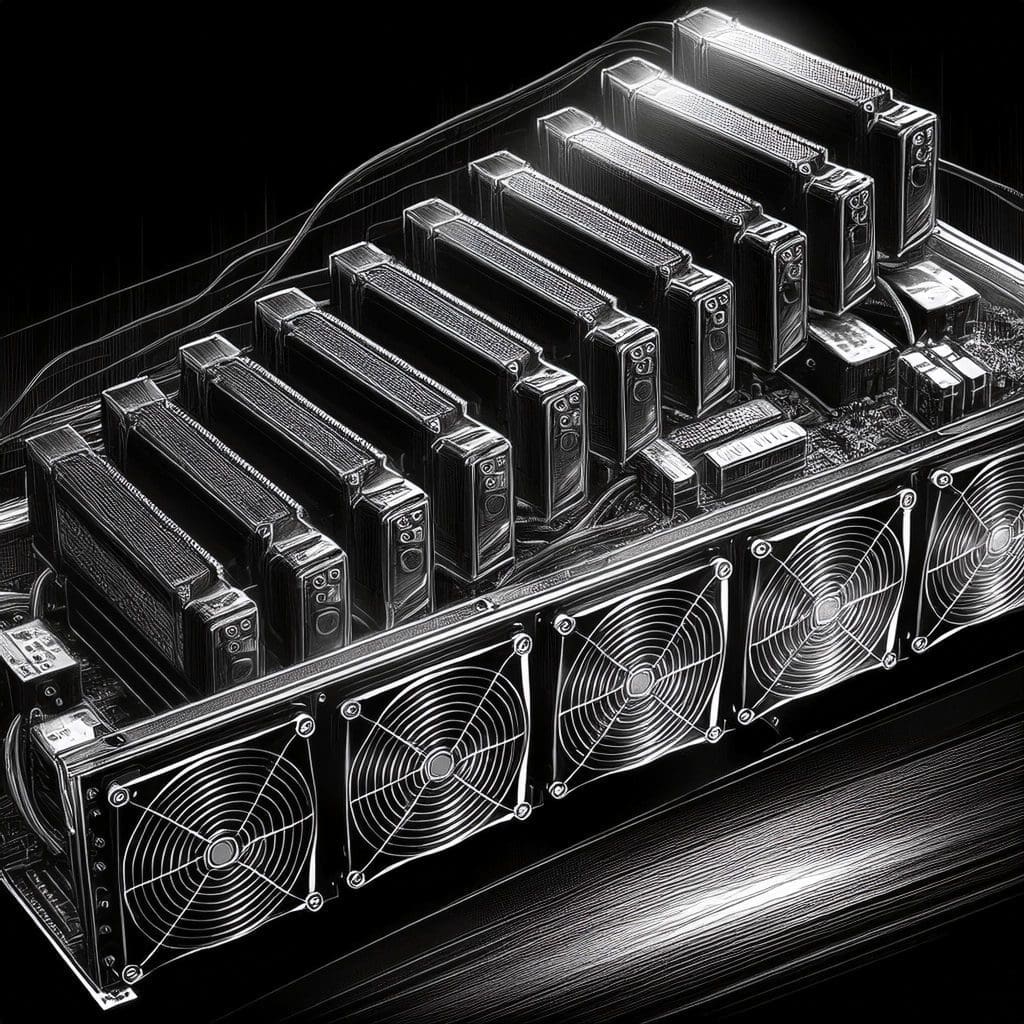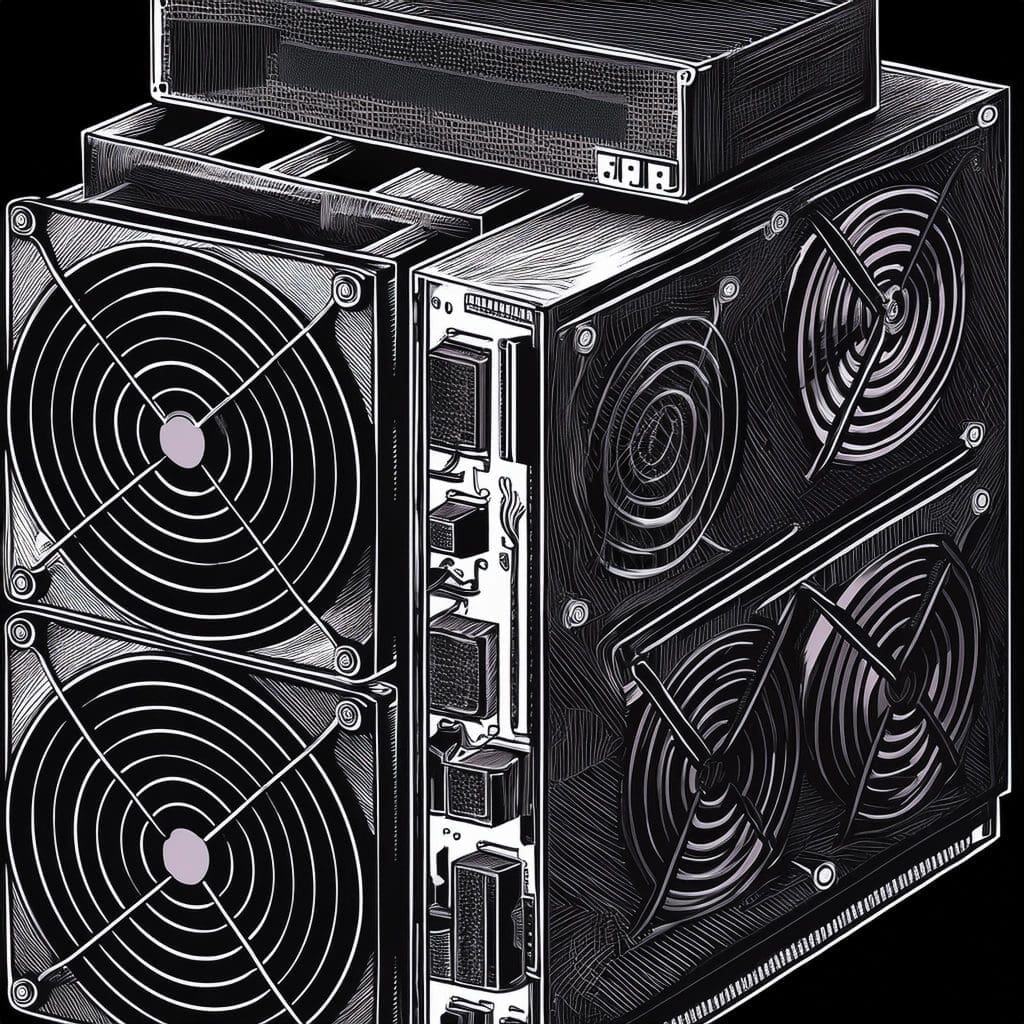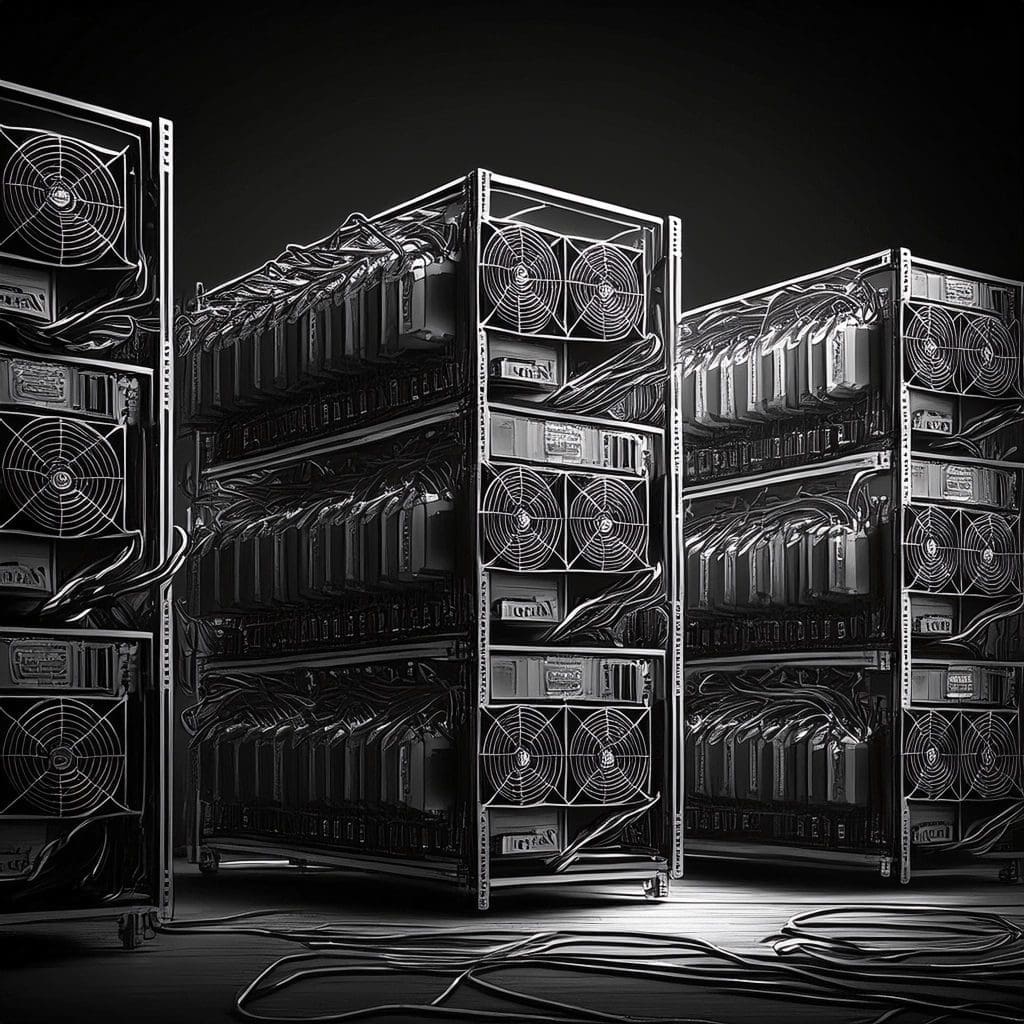GPU Mining Explained: GPU vs ASIC Mining & How They Fit Into Decentralised Mining
Discover the differences between ASIC and GPU mining and their impact decentralisation and profitability.GPU Mining, ASICs & Decentralisation Explained
Introduction
Mining cryptocurrency has become a popular way to participate in the crypto and blockchain space while earning rewards, with many individuals turning to different hardware solutions to boost their efficiency and profitability.
One of the most talked-about methods is GPU mining, but it often gets compared to its more specialised counterpart, ASIC mining. Understanding the crypto mining options available is essential, whether you’re a home PC user or looking to build a larger mining operation.

Large scale mining operation
This article breaks down the key differences between GPU vs ASIC mining, diving into how each functions, their strengths, and weaknesses. We’ll also look at how these technologies impact mining profitability and the larger ecosystem of decentralised mining. By the end, we’ll make sure you have a clear sense of which hardware solution best fits your goals and how it affects the balance of power in the world of crypto mining and blockchain.
What is GPU Mining?

Multiple GPUs being loaded into a mining rig
GPU mining involves using graphics cards known as graphics processing units (GPUs) to handle the complex cryptographic calculations required by blockchain networks. These calculations are critical for verifying transactions and securing the network, which in turn allows miners to earn block rewards as an incentive for their work.
How Does it Work?
GPUs are known for their flexibility and versatility, making them well-suited to mining a broad range of cryptocurrencies. Unlike specialised hardware like ASICs (more on this later), GPUs are capable of adapting to different algorithms, which makes them ideal for altcoin mining.
This adaptability means that miners using GPUs aren’t tied to a single coin; instead, they can switch between various coins based on market conditions or mining profitability.
Altcoin Mining with GPUs
One of the major advantages of GPU mining is the ability to mine thousands of different altcoins.
Cryptocurrencies such as Ethereum Classic, Nexa, Ravencoin, Flux, Kaspa, NEOX, Bitcoin Gold, Cortex, Conflux, and Meowcoin are just a few examples of the coins that can be mined with GPUs.
This gives miners flexibility to switch between coins as market trends shift or when certain coins become more profitable to mine. The adaptability this provides is a significant benefit with how quickly things change and evolve in the crypto space, allowing miners to optimise their mining strategy and rewards over time.
What is ASIC Mining?

A typical ASIC miner
ASIC mining relies on application-specific integrated circuits (ASICs), which are custom-built dedicated hardware units designed to carry out a single hash algorithm. For instance, an ASIC miner built for Bitcoin uses the SHA-256 algorithm to solve cryptographic puzzles on the Bitcoin blockchain.
This specialised hardware is purpose-built for one task, making it extremely efficient for mining a particular cryptocurrency.
How Does it Work?
ASICs are incredibly powerful but come with significant limitations. While their design allows them to excel in terms of performance, they are restricted to mining specific coins tied to the algorithm they support.
As a result, ASICs have come to dominate networks like Bitcoin and Litecoin, where their efficiency gives them a competitive edge over other types of mining hardware. However, this also means that ASICs offer far less flexibility compared to GPUs, as they cannot easily switch between different coins or algorithms.
Crypto Mining with ASICs
ASIC miners are specifically built to mine particular cryptocurrencies efficiently, and as of 2024, several coins have become popular choices for ASIC-based mining, including:
-
Bitcoin: Bitcoin remains the leading cryptocurrency mined with ASICs, using the SHA-256 algorithm. It’s by far the most lucrative and competitive network for ASIC mining. The latest models, like the Bitmain Antminer S19 XP Hyd, deliver exceptional hash rates while being highly power-efficient. These miners dominate the Bitcoin mining landscape, making other hardware nearly obsolete for serious miners.
-
Bitcoin Cash: Sharing the same SHA-256 algorithm as Bitcoin, Bitcoin Cash can be mined with the same ASIC devices. This coin offers a solid alternative for those looking to diversify while maintaining similar levels of profitability. The parallel use of Bitcoin and Bitcoin Cash miners allows miners to switch between these two blockchains, taking advantage of whichever offers better rewards or lower difficulty at the time.
-
Litecoin: Litecoin uses a different algorithm known as Scrypt, which requires specialised ASICs designed for this specific purpose. Devices like the Bitmain Antminer L7 are particularly popular among Litecoin miners for their high efficiency and strong performance. The coin continues to attract ASIC miners due to its established reputation and market liquidity.
-
Dogecoin: Interestingly, Dogecoin shares Litecoin’s Scrypt algorithm, which means the same ASICs used for mining Litecoin can also mine Dogecoin. Miners often dual-mine DOGE and LTC simultaneously, maximising their profitability by earning rewards from both coins at once. This combination has kept Dogecoin relevant in the ASIC mining world, particularly after its surge in popularity in recent years.
-
Kaspa: New to the ASIC mining scene, Kaspa uses the kHeavyHash algorithm, which has seen a surge in interest in 2024. ASIC miners like the Iceriver KS3L have made Kaspa one of the most efficient coins to mine. The coin’s growing popularity and relatively low network difficulty (compared to larger, more established coins) make it an attractive option for miners looking for higher profitability with newer coins.
Many of these coins were initially mineable using GPUs and some (Kaspa for example) still are, but as network competition and difficulty levels increased, GPUs became less viable.
The introduction of ASICs dramatically changed mining for these coins, as their greater efficiency and higher hash rates began to outpace the general-purpose hardware used in GPU mining. This led to a shift where ASICs became essential for maintaining profitability on these networks.
GPU vs ASIC Mining: Key Differences
When deciding between GPU and ASIC mining, there are several critical factors that miners need to consider.
Each hardware option offers unique advantages and drawbacks, which can significantly impact a miner’s long-term strategy. Let’s break down the key differences across several essential areas, from flexibility and cost to efficiency and practicality.

The differences between GPU Mining vs ASICs
Flexibility and Future-Proofing
ASIC miners are highly efficient but lack versatility.
They are designed to mine a single cryptocurrency tied to a specific algorithm, such as SHA-256 for Bitcoin or Scrypt for Litecoin. This makes them incredibly effective at what they do but limits their usefulness if you ever want to mine a different coin.
On the other hand, GPUs offer far more flexibility. They are capable of mining a wide variety of cryptocurrencies, which means you can switch between coins or even take advantage of newly emerging tokens.
This ability to adapt to changing market conditions makes GPUs a more future-proof choice, especially in the unpredictable world of cryptocurrencies. Miners using GPUs are not locked into one coin and can pivot based on profitability and new opportunities.
Price and Upfront Costs
When it comes to upfront costs, ASIC miners tend to be significantly more expensive than GPUs.
A powerful ASIC like the Bitmain Antminer S19 XP can cost several thousand pounds, putting it out of reach for casual or small-scale miners. However, for large-scale operations, this upfront cost is often justified by the faster return on investment (ROI) that ASICs can provide due to their high efficiency and hash rates.
By contrast, GPUs are generally less costly to purchase, making them more accessible to hobbyists and beginners who want to dip their toes into mining without a huge financial commitment.
A rig using multiple GPUs can be built over time, spreading out the initial investment. Though GPU rigs may not offer as fast an ROI as ASICs, their lower entry barrier makes them a popular choice for those starting with smaller budgets.
Mining Efficiency, Budget, and Energy Consumption
ASICs excel in efficiency, offering higher hash rates with lower power consumption.
This is because they are built specifically for a single algorithm, allowing them to optimise their energy use while delivering maximum performance. This efficiency makes ASICs ideal for large-scale operations that need to minimise electricity costs to maintain profitability.
In contrast, GPUs are less efficient in terms of energy consumption but have a different kind of strength: versatility.
While GPUs may require more electricity to achieve competitive hash rates, their ability to mine multiple coins helps them stay profitable. If a particular cryptocurrency becomes less profitable to mine, GPU users can switch to another, often making up for the higher energy costs through adaptability.
ASICs have a higher upfront cost, but they tend to consume less energy in the long run, making them more cost-effective for electricity over time. However, the initial financial outlay is a barrier for many miners. GPUs, on the other hand, are typically more affordable but tend to use more power.
To reach a competitive level of mining performance, GPU miners often need to run multiple units, which increases both energy consumption and cooling requirements, particularly at scale.
Cost and Availability of Mining Hardware
The cost of ASIC miners is often prohibitive, especially for those just entering the market.
ASICs, being specialised hardware, are more expensive upfront because of their dedicated function and the high demand for devices capable of mining profitable coins like Bitcoin. Additionally, once the network difficulty rises or the coin becomes unprofitable to mine, the ASIC can’t easily be repurposed for other uses.
GPUs, while generally more affordable, offer a key advantage: their multi-purpose nature. They can be used for mining various cryptocurrencies and, if no longer needed for mining, can be resold or repurposed for other tasks like gaming or graphic design.
ASICs are often more challenging to source, particularly during times of high demand or supply shortages. Production runs are limited, and they can sell out quickly when market conditions are favourable.
On the flip side, GPUs are more widely available, and you can even find second-hand GPUs for mining setups. Their broad use beyond mining, in industries like gaming and AI, means they are generally easier to purchase and replace if needed.
Practicality and Ease of Use
For both small and large-scale operations, there are key differences in setup and ongoing maintenance.
ASICs are generally simpler to set up, requiring less technical knowledge and fewer components. They are often plug-and-play, making them easier to deploy for larger operations. However, their specialisation means they don’t offer much long-term flexibility—once their dedicated algorithm or coin becomes unprofitable, the ASIC hardware may become obsolete.
On the other hand, GPU rigs are typically more versatile but can be more complex to build and maintain. A GPU mining setup involves more components, including risers, multiple GPUs, and cooling solutions.
That said, GPU rigs can also come prebuilt and be purchased from suppliers who configure them in compact, enclosed cases. For GPU rigs like these, they are no more complex than an ASIC and it’s as simple as putting together a computer. They can also be easily modified or expanded, making them suitable for miners who plan to switch between different coins or upgrade hardware regularly.
Home Mining Considerations
When it comes to home mining, ASIC miners tend to generate significant noise and heat, which makes them less suitable for residential setups.
The sound of an ASIC can resemble that of an industrial machine, and the heat output often requires advanced cooling solutions to prevent overheating.
In contrast, GPUs are typically quieter and generate less heat, making them a more appropriate choice for home mining rigs. Though they still require some cooling, GPU rigs can be placed in compact cases that can fit on a desk or shelf without causing too much disturbance.
Mining Farm Considerations
For large-scale mining farms, ASICs are often the preferred choice. Their efficiency and ease of use make them ideal for operations where space and energy costs are significant concerns.
ASIC farms are easier to manage because of their straightforward design, requiring less space for cooling and maintenance.
However, GPUs provide a different kind of advantage when scaling. Although they may take up more space and require additional energy for cooling, they offer much greater flexibility.
In an industry where profitability is tied to market fluctuations, having a GPU farm means miners can adjust their operations to changing market conditions. While more difficult to manage at scale, GPU farms offer a hedge against market volatility.
Centralised vs Decentralised Mining
The debate between centralised and decentralised mining is a crucial one in the cryptocurrency community. It touches on fundamental concerns regarding network security, fairness, and the overall integrity of blockchain systems.
At its core, the difference boils down to how power, particularly hashing power, is distributed across the network.

The concept of decentralised mining
What is Decentralised Mining?
Decentralised mining refers to the distribution of mining power across a broad base of participants rather than concentrating it within a few large entities or mining pools. The goal is to prevent any single party or group from having too much influence over the network.
In a decentralised system, miners from all over the world—ranging from individuals running rigs at home to small-scale operations—contribute to the network’s security by verifying transactions and maintaining the blockchain.
This approach aligns with the original vision of cryptocurrencies like Bitcoin, which aimed to create an open, transparent, and tamper-resistant financial system. However, as mining has become more competitive, some networks have seen increasing centralisation, especially in ASIC-dominated networks.
Performance vs Security Trade-offs of Decentralisation in Mining
One of the key benefits of decentralised mining is enhanced security.
When mining power is spread across thousands or millions of participants, it becomes significantly harder for any single entity to launch a 51% attack (where a miner or group controls the majority of the network’s hash rate and can manipulate transactions). This makes the blockchain more resistant to malicious attacks and ensures that no single party has disproportionate control over the system.
However, decentralisation can sometimes come at the expense of performance.
Since decentralised networks rely on many smaller miners, transaction processing may not be as fast as in centralised systems where a few powerful miners dominate. This is because a widely distributed mining network can result in longer block times and potentially slower consensus mechanisms.
While security is prioritised, transaction speed can be slower in some decentralised models compared to centralised ones, where fewer miners, often using high-powered ASICs, can process blocks more quickly.
How GPU Mining Supports Decentralisation
GPUs play an essential role in supporting decentralised mining.
Unlike ASIC miners, which are expensive and often only accessible to large operations, GPUs are widely available and can be used by smaller miners or even individuals on home PCs. This allows more people to participate in the mining process, distributing the network’s power more evenly.
By giving smaller-scale miners the ability to contribute to the network, GPU mining helps prevent the concentration of mining power in the hands of large mining farms.
As long as miners can switch between various cryptocurrencies, GPU mining ensures that decentralised networks remain viable and accessible to a broader range of participants, reinforcing the concept of a distributed blockchain ecosystem.
Decentralised Mining for Blockchain Security
One of the primary benefits of decentralised mining is its ability to strengthen network security.
With mining power spread across a wide pool of participants, it becomes increasingly difficult for any single entity or mining pool to gain enough control to manipulate the blockchain.
This distribution of hashing power is key to preventing 51% attacks, where one party could theoretically rewrite parts of the blockchain to reverse transactions or double-spend coins.
In a decentralised network, even small miners can play an important role in maintaining the integrity of the blockchain. By contributing their hashing power, they help to ensure that no single party can dominate the network, keeping the system secure and transparent for all users.
ASIC Centralisation Risks
While ASIC miners bring exceptional efficiency and hashing power, they also come with a significant risk: centralisation.
The cost and specialised nature of ASICs often lead to large mining farms or industrial-scale operations controlling the majority of the mining power. This centralisation creates a situation where a small number of entities or pools hold a disproportionate share of the network’s influence.
This poses a risk to the decentralised nature of blockchain technology. If a few ASIC-dominated mining pools were to consolidate their power, they could theoretically gain the ability to influence or even control the network.
Such centralisation could lead to issues like censorship, manipulation of transactions, and weakening the overall security and trust in the blockchain.
Crypto Mining Profitability – GPU Mining vs ASIC Miners
Mining profitability is one of the most critical factors when deciding between GPU vs ASIC mining.
There are multiple variables that affect long-term returns, from upfront costs and electricity consumption to the ability to adapt to market trends. Here’s how both options compare across key profitability factors.

Crypto mining profitability factors
Upfront Costs to Purchase and Time to Earn a Return
The upfront cost of the hardware plays a significant role in determining mining profitability.
ASIC miners are generally more expensive to purchase compared to GPUs. For example, top-tier ASIC miners like the Bitmain Antminer S19 XP can cost several thousand pounds, making the initial investment quite steep.
However, this high cost is often offset by their exceptional efficiency and higher hash rates, which allow ASIC miners to achieve a faster return on investment (ROI)—especially in large-scale mining operations.
On the other hand, GPUs are more affordable upfront, with individual graphics cards like the NVIDIA GeForce RTX 4090 costing much less compared to a high-end ASIC.
For hobbyists or small-scale miners, the lower entry price of GPUs makes them a more accessible option. However, achieving a competitive ROI with GPUs can take longer, particularly in networks where ASICs dominate. The key advantage for GPU miners is the ability to scale their operations gradually, adding more GPUs over time without the need for a large initial capital outlay.
Versatility to Adapt to Market Conditions
One of the biggest advantages of GPU mining is its versatility.
Since GPUs are not tied to a single algorithm, they offer the flexibility to mine thousands of altcoins, allowing miners to switch between different cryptocurrencies based on profitability.
For example, if the market for one coin becomes less profitable or the network difficulty rises, GPU miners can easily switch to another coin that offers better returns. This adaptability is crucial in the ever-evolving cryptocurrency space, where market trends can change rapidly.
In contrast, ASIC miners are designed for a specific coin or algorithm, such as SHA-256 for Bitcoin or Scrypt for Litecoin. While this specialisation gives ASICs a clear efficiency advantage in mining their target coins, it also limits their ability to adapt. If the coin they are designed for becomes less profitable, ASIC miners have fewer options, making them more vulnerable to shifts in the market.
Electricity Costs and Mining Profitability
Electricity costs are another critical factor in determining mining profitability, especially given the energy-intensive nature of crypto mining.
ASIC miners tend to be more energy-efficient than GPUs, providing higher hash rates per watt of electricity consumed. This efficiency makes ASIC miners a more cost-effective option for large operations where energy costs are a significant expense.
By consuming less power while delivering higher performance, ASICs help keep electricity costs down, which improves overall profitability.
However, while GPUs may require more electricity to achieve comparable hash rates, they offer miners the ability to switch algorithms and mine different coins. This flexibility can keep GPU miners profitable, even if energy consumption is higher.
By moving to more energy-efficient algorithms or targeting coins with less competition, GPU miners can offset their higher electricity costs. In regions where electricity prices are low or where renewable energy is available, GPU miners may still find their operations profitable despite their higher power use.
Long-Term Viability and Resale Value
When considering the long-term viability of mining hardware, one important factor that often gets overlooked is resale value. While both GPUs and ASICs are capable of generating income through mining, their future worth beyond mining differs significantly.
Resale Value of GPUs
GPUs hold a clear advantage when it comes to resale value.
The primary reason for this is their multi-functional nature. Even if cryptocurrency mining becomes unprofitable or shifts to other types of hardware, GPUs can be repurposed for a wide range of tasks.
Their versatility extends far beyond mining; they can be used for gaming, video editing, 3D rendering, or even machine learning applications.
As a result, the second-hand market for GPUs remains strong, and many miners can recoup a good portion of their initial investment by selling their hardware once they’re done mining.
This makes GPUs a more future-proof option for miners who may want to pivot or exit the mining space altogether.
Resale Value of ASICs
In contrast, ASICs are far more limited in their resale potential.
Since they are designed to perform one specific task—mining a single cryptocurrency or algorithm—there’s little use for them outside of this purpose.
Once an ASIC miner becomes obsolete, whether due to rising network difficulty, unprofitability, or newer models entering the market, its resale value drops significantly.
The only real buyers for second-hand ASICs are other miners interested in the specific coin or algorithm that the ASIC was designed for. This niche market means that miners using ASICs often face depreciation much faster than GPU owners, and there is a smaller chance of recovering a significant portion of the initial investment.
Additionally, the rapid pace of technological advancement in the ASIC market can make older models quickly outdated. As newer, more efficient ASICs are released, older models become less competitive, which further reduces their resale value.
In contrast, even an older GPU can retain value for gaming or creative work, as it can still perform well in those areas despite being outdated for mining.
Choosing the Right GPU for Mining
Selecting the right GPU for mining is a critical decision, as it directly impacts your mining efficiency, power consumption, and overall profitability.
While there are many GPUs on the market, not all are equally suited for mining. To help you make an informed decision, it’s important to weigh several factors such as hash rate, energy consumption, and price.

Choosing the best GPU for mining
Here are some key factors to consider:
Hash Rate
The hash rate measures the processing power of a GPU in terms of how many cryptographic calculations it can perform per second.
A higher hash rate means more blocks solved and more rewards earned. When choosing a GPU, it’s important to look for a model with a competitive hash rate for the coins you plan to mine.
For example, the NVIDIA GeForce RTX 4090 boasts one of the highest hash rates currently available with up to 140 MH/s for Ethereum Classic for example, making it a top choice for miners.
Similarly, the AMD Radeon RX 7900 XTX offers excellent hash rates, particularly for memory-intensive algorithms, making it another strong contender for miners who want high performance. Both cards excel in their ability to handle complex mining tasks efficiently.
Energy Consumption
Energy efficiency is a critical factor in determining long-term mining profitability.
While high-end GPUs may offer impressive hash rates, they often come with increased power usage. It’s essential to strike a balance between hash rate and energy consumption to avoid diminishing returns.
The NVIDIA RTX 4090 is relatively power-hungry, with an average consumption of around 450 watts, so miners need to account for this when calculating electricity costs. However, its high hash rate helps offset some of the energy costs through faster block rewards.
On the other hand, the AMD Radeon RX 7900 XTX is slightly more efficient in terms of power consumption, operating at around 355 watts, while still delivering solid mining performance.
Miners with access to cheaper electricity or renewable energy sources might find higher-wattage cards acceptable, while those paying premium rates should prioritise GPUs with a lower power draw to maximise profit margins.
Price
The price of the GPU plays a crucial role in your initial investment and overall ROI.
High-performance GPUs like the RTX 4090 and RX 7900 XTX are at the higher end of the market, often costing over £1,000.
While they deliver excellent hash rates and can mine a variety of altcoins, the upfront cost can be steep, especially for smaller-scale miners or those just starting out.
If you’re working with a more modest budget, consider older models like the NVIDIA RTX 3060 Ti or AMD Radeon RX 6700 XT.
These cards still provide respectable mining performance, particularly for altcoins, while being more affordable and power-efficient.
The key is to balance your budget against the card’s mining efficiency and hash rate to ensure you’re making a wise investment.
The Evolution of Mining
Cryptocurrency mining has undergone significant changes since Bitcoin’s inception in 2009.
As the industry has grown and matured, so has the technology used to mine coins. What started with basic CPU mining has evolved through GPUs and now to ASICs—each step in this evolution has shaped the landscape of mining, influencing everything from profitability to decentralisation.

All things evolve
From CPUs to GPUs
In the early days of Bitcoin mining, miners used CPUs (Central Processing Units)—the standard processors found in everyday computers.
At the time, Bitcoin’s network difficulty was relatively low, allowing hobbyists to mine coins with little more than their home PCs. Mining was accessible, and profits were easy to come by, even for those with modest hardware setups. However, as more miners joined the network, the difficulty level increased, and CPUs could no longer compete.
The next phase in mining’s evolution came with the introduction of GPUs. Initially designed for rendering graphics in video games, GPUs proved to be far more efficient than CPUs at handling the parallel processing needed for cryptographic algorithms. This is because GPUs are better suited for performing multiple calculations simultaneously, making them ideal for mining cryptocurrencies like Bitcoin.
GPUs also introduced a level of versatility that CPUs lacked. Unlike CPUs, which were limited in their processing power for blockchain-related tasks, GPUs could handle more complex, memory-hard algorithms.
This development was crucial for the mining of alternative cryptocurrencies, or altcoins, which relied on different hashing algorithms than Bitcoin. Ethereum is a prime example, as its memory-hard Ethash algorithm made GPU mining a practical and efficient method for securing the network.
The rise of GPU mining opened up opportunities for a wider range of people to participate in the industry, as miners could target various cryptocurrencies with a single setup.
The Rise of ASICs
As cryptocurrency mining continued to grow, ASICs entered the scene, marking the next stage of mining hardware evolution. Unlike GPUs, which could mine various coins by adjusting algorithms, ASICs are specialised devices designed to perform a single task—mining a specific cryptocurrency based on one algorithm.
The first ASICs were introduced for Bitcoin mining, focusing solely on the SHA-256 algorithm. ASICs brought unprecedented levels of efficiency, boasting significantly higher hash rates and much lower energy consumption compared to GPUs and CPUs.
This leap in performance made ASICs the dominant hardware for mining Bitcoin and other cryptocurrencies that adopted similar algorithms, such as Litecoin (which uses the Scrypt algorithm).
While ASICs revolutionised the industry by making large-scale mining more profitable, they also contributed to the centralisation of mining power.
The high cost of ASIC miners, coupled with their specialised nature, meant that only miners with significant resources could afford them. This shift led to the rise of large mining farms and industrial-scale operations, reducing the influence of smaller, independent miners who relied on GPUs.
How GPUs Revolutionised Crypto Mining
Though ASICs currently dominate Bitcoin and other large networks, GPUs played a pivotal role in shaping the broader mining industry.
Their ability to handle memory-hard algorithms—which are resistant to ASIC dominance—revolutionised mining for altcoins like Ethereum and Monero. Memory-hard algorithms require more memory bandwidth, making them inefficient for ASICs and therefore preserving decentralisation in those networks.
The flexibility of GPUs also made it easier for miners to adapt to changing market conditions.
When Bitcoin mining became dominated by ASICs, many miners shifted their focus to altcoins that could still be profitably mined using GPUs. This versatility extended the lifespan of GPU mining far beyond what many had initially expected, and even today, GPUs are crucial for maintaining decentralised mining in many networks.
As new coins and algorithms emerge, GPUs remain relevant because of their multi-purpose capabilities.
While ASICs may dominate individual blockchains, GPUs can still thrive in a diversified mining portfolio, especially as new proof-of-work coins or memory-hard algorithms come into play.
Pros and Cons of GPU Mining vs ASIC Miners in Decentralised Networks
When evaluating GPU mining vs ASIC mining in decentralised networks, it’s essential to consider the strengths and weaknesses of each approach.
Both hardware types offer distinct advantages and disadvantages, especially when viewed through the lens of decentralisation and mining efficiency.
Pros of GPU Mining
-
Flexibility: One of the biggest advantages of GPU mining is its ability to mine a wide range of cryptocurrencies. Since GPUs are not locked into a single algorithm, they offer the flexibility to switch between different coins, allowing miners to respond to shifts in market trends or profitability. This flexibility makes GPUs particularly valuable in a rapidly changing crypto environment.
-
Ability to Mine Multiple Coins: Unlike ASIC miners, which are designed for one specific coin or algorithm, GPUs can handle thousands of altcoins. This ability to mine multiple cryptocurrencies helps maintain a decentralised ecosystem, as smaller miners can participate in different networks without the need for specialised hardware.
-
Contribution to Decentralisation: GPUs play a vital role in promoting decentralisation. Since they are more affordable and widely available than ASICs, they enable more individuals and smaller-scale operations to participate in mining. This prevents large-scale farms from dominating the network, helping to distribute hashing power across a broader base of users, thus strengthening network security.
Cons of GPU Mining
-
Lower Hash Rate: GPUs typically offer a lower hash rate compared to ASICs, which means they are less powerful in terms of raw mining performance. While GPUs can mine many different coins, their slower hash rates mean they may struggle to compete on networks dominated by ASICs, particularly for coins like Bitcoin where hash rate is critical for profitability.
-
Higher Energy Consumption per Unit: On a per-unit basis, GPUs are generally less energy-efficient than ASICs. To achieve competitive mining power, multiple GPUs are often required, which increases electricity costs and cooling requirements. This can make GPU mining less profitable in regions where electricity prices are high, though algorithm switching can sometimes offset these costs by allowing miners to focus on more energy-efficient coins.
Pros of ASIC Mining
-
Higher Efficiency and Hash Rate for Specific Coins: ASIC miners are designed for a specific algorithm, allowing them to deliver maximum efficiency and hash rate for that coin. This makes ASICs the go-to option for miners looking to achieve the highest possible performance on networks like Bitcoin or Litecoin. Their high efficiency also means lower electricity costs per hash, which can lead to faster returns on investment (ROI).
-
Better for Large-Scale Operations: ASICs are ideal for large-scale operations. Their power efficiency and higher performance make them better suited for industrial mining farms that focus on maximising profitability through sheer mining power. ASICs are particularly beneficial for miners with access to cheap electricity and large facilities where they can operate in bulk.
Cons of ASIC Mining
-
Expensive: ASIC miners are generally more expensive to purchase than GPUs. Their specialised nature means they come with a higher upfront cost, which can be a barrier for smaller miners or those just starting out. Additionally, once an ASIC miner becomes obsolete, either due to rising network difficulty or newer models being released, its resale value can drop significantly.
-
Less Flexible: ASICs are built for one specific algorithm, making them far less flexible than GPUs. If the cryptocurrency tied to their algorithm becomes less profitable, there are limited options for pivoting to another coin. This lack of versatility ties miners to a specific network, which can be a disadvantage when market conditions change or if a new coin becomes more profitable to mine.
-
Contribution to Mining Centralisation: Due to their high cost and specialised nature, ASIC miners often lead to the centralisation of mining power. Large mining farms with significant resources can afford to dominate a network, leaving smaller miners with fewer opportunities. This concentration of hashing power in the hands of a few can pose a security risk to the network, undermining the principles of decentralisation that many cryptocurrencies were built upon.
Determining Goals Before Deciding on GPU or ASIC Mining
Choosing between GPU and ASIC mining depends heavily on your mining goals.
Defining these goals before you invest in hardware can save you time, money, and potential frustration.
Whether you’re focused on maximising profits, contributing to decentralisation, or gaining experience with blockchain technology, your objectives will guide your decision-making process.
-
Maximising Profits: If your primary goal is to maximise profitability, then the choice between ASIC and GPU will depend on the specific coin or coins you want to mine. ASIC miners are typically more profitable for established, high-difficulty coins like Bitcoin, as they offer higher hash rates and greater energy efficiency. However, they come with a higher initial cost and a lack of flexibility. GPU miners, on the other hand, can remain profitable by switching to different altcoins based on market conditions. If you’re looking for steady, predictable profits, ASICs may be the better choice. If you’re willing to adapt and monitor market trends, GPUs offer more flexibility.
-
Contributing to Decentralisation: For miners who want to support decentralisation, GPU mining is the better option. GPUs allow smaller miners to participate in the network without needing to invest heavily in specialised hardware. This helps distribute hashing power across more participants, preventing mining centralisation and maintaining network security. If your goal is to contribute to a fair and decentralised ecosystem, especially for coins like Ethereum Classic or Monero, GPU mining is the way to go.
-
Gaining Experience in Blockchain Technology: If you’re new to cryptocurrency and interested in learning about blockchain technology, GPU mining provides a good entry point. It’s less expensive than ASIC mining and offers the opportunity to mine multiple coins, giving you hands-on experience with different algorithms and blockchain networks. Additionally, GPUs can be repurposed for non-mining activities, such as gaming or content creation, which makes them a less risky investment if you’re not yet fully committed to mining.
-
Hobbyist vs Large-Scale Professional Mining: Your scale of operation also plays a role in hardware choice. GPU mining is often more suited to hobbyists or small-scale miners, as the lower upfront cost and flexibility allow for a more gradual approach to building a mining setup. On the other hand, ASIC mining is better suited to those who are treating mining as a professional, large-scale operation. If you have access to cheap electricity and plan to mine at scale, ASIC miners are likely the more efficient option.
Last modified on: April 18, 2025

Basic Economics & Cryptocurrency Valuation
Why I've Written This Article? One of the most common, and most frustrating, objections (misconceptions) that I hear...

About CryptosRUs and Into the Cryptoverse
This post exploring CryptosRUs vs Into the Cryptoverse for free crypto advice is a little different to others we...

From Everyday People & General Adoption to the Bitcoin Elites: Who Will Benefit the Most?
IntroductionOn 6th September 2023, we published a massive article titled ‘Detailed Analysis of Projected Bitcoin...

How The Price of Bitcoin is Impacted by External Drivers & Forces
Introduction On 6th September 2023, we published a massive 10K word article titled ‘Detailed Analysis of Projected...
Contact us to order your crypto mining rig today
Address
Opace Ltd t/a Crypto Mining Solutions, Park House, Bristol Rd South, Rubery, Birmingham, West Midlands, B45 9AH. UK
Phone
0845 017 7661
